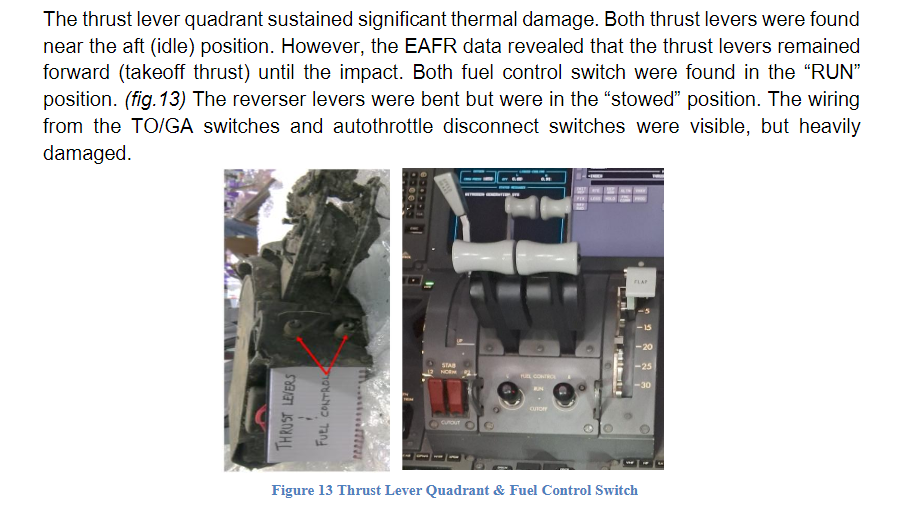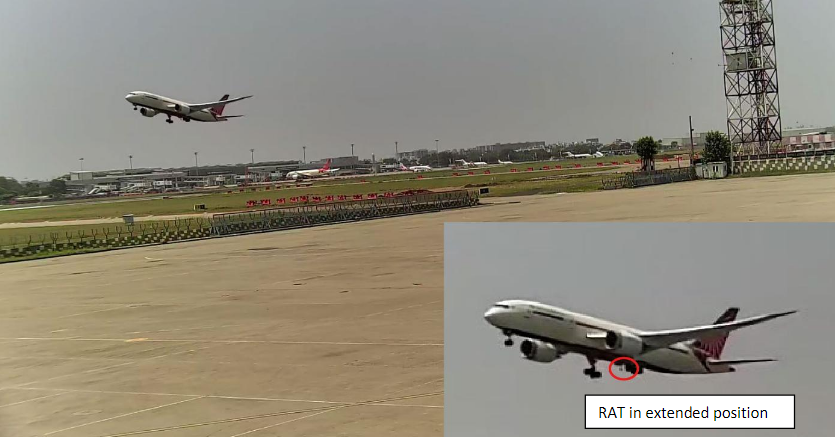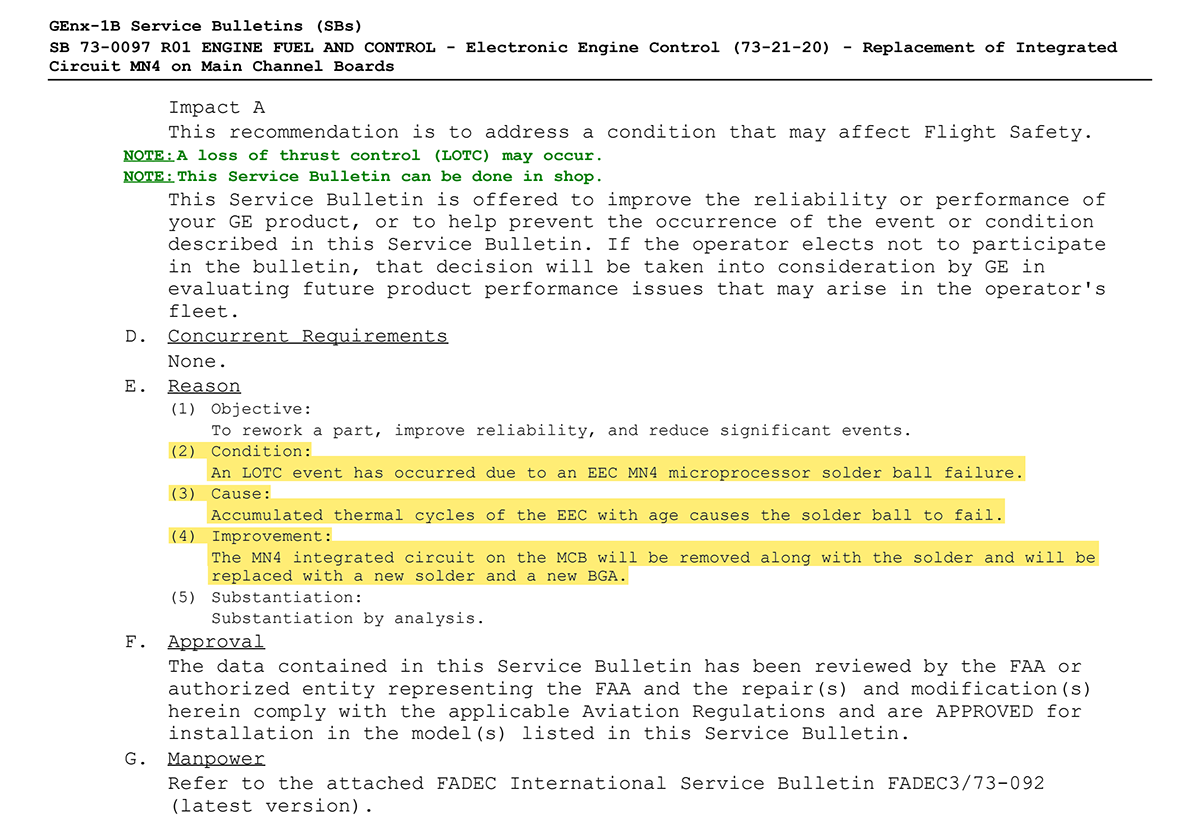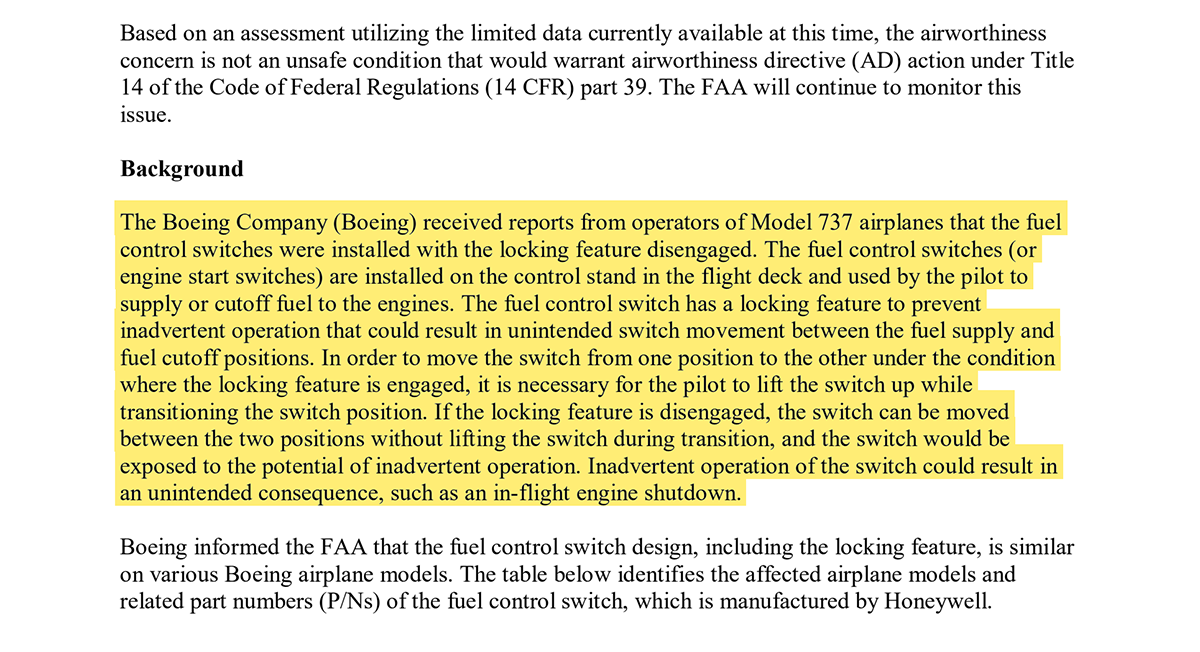What Happened to Air India Flight 171?
This crash was one of the most devastating and mysterious crashes in recent aviation history. Did the plane go down right after takeoff because of a malfunction or because the pilots cut the fuel supply to the engines?

The recovered fuel cutoff switches (screenshot of the AAIB preliminary report)
On 12 June, Air India Flight 171 crashed in Ahmedabad right after takeoff, killing 241 people on board the accident aircraft (VT-ANB) and 39 people in a medical college on the ground. The Aircraft Accident Investigation Bureau (AAIB) of India released a preliminary report on the accident on 12 July.
Loss of Thrust During Takeoff
Since the aircraft, a Boeing 787 Dreamliner, seems to have lost thrust right after takeoff in both engines simultaneously, the report focuses on possible causes for this, as well as symptoms of it, like the ram air turbine (RAT) of the plane, which was visibly deployed in video footage showing the plane when it lost altitude — indicating double engine failure and loss of electrical power. The aircraft’s APU seems to also have engaged.
The APU was inspected and found intact inside the APU compartment. The APU air inlet door, which was intact, was found open.
The report also looks at the flap handle, landing gear lever, fuel cutoff switches, thrust levers and TO/GA switches as found in the wreckage. All of these settings could have played a role in why the aircraft suddenly lost altitude.
The flap handle assembly sustained significant thermal damage. The handle was found to be firmly seated in the 5-degree flap position, consistent with a normal takeoff flap setting. The position was also confirmed from the EAFR1 data. The landing gear lever was in “DOWN” position.
The thrust lever quadrant sustained significant thermal damage. Both thrust levers were found near the aft (idle) position. However, the EAFR data revealed that the thrust levers remained forward (takeoff thrust) until the impact. Both fuel control switch were found in the “RUN” position. The reverser levers were bent but were in the “stowed” position. The wiring from the TO/GA switches and autothrottle disconnect switches were visible, but heavily damaged.
With the flaps deployed correctly for takeoff, the thrust reversers stowed and the fuel cutoff switches set to supply the engines with fuel, the plane should have had enough thrust to continue its takeoff, even with the gear still down. The landing gear would have caused increased drag, but not enough to stall the plane, of course.

Video surveillance footage from the airport shows the plane's RAT has deployed right after takeoff (Screenshot from the AAIB report)
However, the fact that the RAT was already deployed when the plane was still gaining height, points at electrical issues, most likely to do with the engines (which generate the plane’s electrical power as well as its thrust).
Timeline of the Crash
As per the EAFR data, the aircraft crossed the take-off decision speed V1 and achieved 153 kts IAS at 08:08:33 UTC. The Vr speed (155 kts) was achieved as per the EAFR at 08:08:35 UTC. The aircraft air/ground sensors transitioned to air mode, consistent with liftoff at 08:08:39 UTC.
The aircraft achieved the maximum recorded airspeed of 180 Knots IAS at about 08:08:42 UTC and immediately thereafter, the Engine 1 and Engine 2 fuel cutoff switches transitioned from RUN to CUTOFF position one after another with a time gap of 01 sec. The Engine N1 and N2 began to decrease from their take-off values as the fuel supply to the engines was cut off.
In the cockpit voice recording, one of the pilots is heard asking the other why did he cutoff. The other pilot responded that he did not do so.
So three seconds after liftoff, both engines lost their fuel supply due to both fuel cutoff switches being flipped one after the other, with one pilot noticing the loss of power and the other denying that he touched the switches.
As per the EAFR data both engines N2 values passed below minimum idle speed, and the RAT hydraulic pump began supplying hydraulic power at about 08:08:47 UTC.
Five seconds after the switches are toggled to CUTOFF, the engines turn off completely.
As per the EAFR, the Engine 1 fuel cutoff switch transitioned from CUTOFF to RUN at about 08:08:52 UTC. The APU Inlet Door began opening at about 08:08:54 UTC, consistent with the APU Auto Start logic. Thereafter at 08:08:56 UTC the Engine 2 fuel cutoff switch also transitions from CUTOFF to RUN. When fuel control switches are moved from CUTOFF to RUN while the aircraft is inflight, each engines full authority dual engine control (FADEC) automatically manages a relight and thrust recovery sequence of ignition and fuel introduction.
Ten seconds after the switches were toggled to CUTOFF, someone toggles the switch for the left engine back to RUN. Four seconds later, the switch for the right engine is also moved back to RUN. Both engines are now restarting, but the plane is already losing altitude quickly and crashes 15 seconds later, while both engines are still recovering and not able to supply thrust yet.
| Time Index | Flight Recorder Data |
|---|---|
08:08:39 UTC |
Liftoff |
08:08:42 UTC |
Cutoff switches toggled on both engines |
08:08:52 UTC |
Left engine fuel reingaged |
08:08:56 UTC |
Right engine fuel reingaged |
08:09:05 UTC |
MAYDAY transmitted |
08:09:11 UTC |
Data recording stops, plane destroyed |
Possible Technical Issues
After the AAIB’s preliminary report was released, The Aviation Herald cited Indian media reports as saying that the investigation “is not focussing on a human action causing the fuel switches to appear in the CUTOFF position, but on a system failure”. Two documents are of interest when it comes to technical problems with this kind of aircraft that could have caused both engines to loose power or the cockpit switches to be toggled inadvertendly.
The first is a service bulletin issued by the engine manufacturer GE in December 2020 and distributed by the US Federal Aviation Administration (FAA). This bulletin concerns the engines on the 787 and warns of a chip located within the engine control unit (ECU) that could lose connection to its circuit board due to bad solder points that weaken with age under the heat and vibration within the engine. The chip in question is called an MN4 BGA microprocessor.

An excerpt of GE service bulletin 2021-0273-0013 Attachment 2
This could cause the engine to lose power. This maintenance was apparently not performed on the accident aircraft. It does not seem to explain why both engines lost power at almost the exact same time, though. It also doesn’t explain why the fuel cutoff switches were toggled.
The second document concerns these fuel cutoff switches. In December 2018, the FAA issued a Special Airworthiness Information Bulletin (SAIB) that concerns a large number of Boeing airplanes, including the 787. This directive, SAIB NM-18-33, warns of fuel cutoff switches being installed wrongly on these planes.

The fuel cutoff switches are the two black knobs located in the lower part of the thrust lever quadrant, under the two big thrust levers (photos from the AAIB preliminary report; accident aircraft on the left, reference from an intact 787 on the right)
Normally, you can’t simply toggle these switches. You need to pull them out with some force, move the switch to the other position and release it. This prevents them from being bumped or otherwise accidentally toggled. Boeing had installed these switches in a way that allowed them to be simply toggled by moving them, nullifying this safety feature.

An excerpt from the FAA's SAIB NM-18-33 concerning fuel cutoff switches on Boeing planes
Since complying with an SAIB is optional, Air India opted to not carry out this maintenance on the plane in question, as per the AAIB’s preliminary report.
This SAIB was issued based on reports from operators of Model 737 airplanes that the fuel control switches were installed with the locking feature disengaged. The airworthiness concern was not considered an unsafe condition that would warrant airworthiness directive (AD) by the FAA. The fuel control switch design, including the locking feature, is similar on various Boeing airplane models including part number 4TL837-3D which is fitted in B787-8 aircraft VT-ANB. As per the information from Air India, the suggested inspections were not carried out as the SAIB was advisory and not mandatory.
However, the entire throttle control module was replaced in 2019 and again in 2023. It seems unlikely that both these newer units had the faults first reported in late 2018.
The scrutiny of maintenance records revealed that the throttle control module was replaced on VT-ANB in 2019 and 2023. However, the reason for the replacement was not linked to the fuel control switch. There has been no defect reported pertaining to the fuel control switch since 2023 on VT-ANB.
On the other hand, the fact that both cutoff switches were initially toggled within a second of each other seems to point to the locking feature not working as intended. It seems a stretch that both switches were toggled by pulling them out and releasing them, one after the other, within as second. At least unless this was done very purposefully.
The Human Factor
Which leads us to reporting that the investigation should maybe shift to the pilots involved. According to The Wall Street Journal, it was the first officer (who was flying the plane at the time) who asked the other pilot (the captain, who was monitoring the flight) why he had cut off the fuel.
A black-box recording of dialogue between the flight’s two pilots indicates it was the captain who turned off switches that controlled fuel flowing to the plane’s two engines, according to people familiar with U.S. officials’ early assessment of evidence uncovered in the crash investigation. The first officer who was flying the Boeing 787 Dreamliner asked the more-experienced captain why he moved the switches to the “cutoff” position after it climbed off the runway, these people said. The first officer expressed surprise and then panicked, these people said, while the captain seemed to remain calm.
The captain, Sumeet Sabharwal, was a decadeslong veteran, while the first officer, Clive Kunder, was in his early 30s and eager for the next stage of his career, friends and family members said. As the pilot actively flying, Kunder likely would have had his hands full pulling back on the Dreamliner’s controls at that stage of the flight, according to U.S. pilots who have read the Indian authorities’ report. Sabharwal, as the pilot monitoring, would have been more likely to have had his hands free as he oversaw the operation.
Remaining completely calm at a point where both your engines are off a few seconds into takeoff and you’re hurtling towards a densly populated urban area at an unrecoverable rate of descent certainly seems a bit odd. You’d think if the captain had toggled these switches by mistake, he would have exclaimed in surprise or frustration when he realised his error. If he had toggled the switches, one after the other, on purpose, however, he must have known that it was almost certain suicide.
The preliminary details have fueled the belief among some U.S. officials that criminal authorities should review the matter, as would likely be the case if the crash had occurred on American soil, people familiar with the matter said. In the U.S., accident investigators historically have involved agencies such as the FBI if they believe a potential crime occurred, rather than a safety mishap.
Of course, if it wasn’t a technical issue and either pilot error or even a deliberate attempt at crashing the plane, we might never know for sure.
Sabharwal, the 56-year-old pilot who served as captain on the Air India flight, was a soft-spoken man devoted to caring for his ailing father, according to friends and neighbors. They said his father, who served as a bureaucrat in India’s civil aviation ministry, inspired his aviation career.
Kapil Kohal, an Air India pilot and friend of Sabharwal, overlapped with him for one year in flight school. Kohal said Sabharwal stood out among their classmates—very polite, never cursed, never drank alcohol, and spoke so softly that sometimes Kohal had to ask him to speak louder. “He was a very reserved guy right from the beginning,” Kohal said. Sabharwal’s serious demeanor, along with the way his eyes turned down at the corners, earned him the nickname “Sad Sack,” Kohal said.
Unlike other students’ messy quarters, Sabharwal kept a spartan room filled with the bare minimum. “If you open his cupboard, there were two formal shirts, two T-shirts, two pairs of shoes, one slippers, and one bag,” Kohal said.
He was driven by a sheer love of flying, Kohal said, and showed a flair for mentoring younger students. When Kohal was assigned to shadow Sabharwal on a flight, he explained flying concepts better than some instructors. He was “a middle class boy looking at the sky and saying, I want to be there,” Kohal said.
According to reporting by The Telegraph, the captain had a known record of mental health issues.
Captain Sumeet Sabharwal, who was 56, was months from retirement but had been considering leaving the airline to look after his elderly father following the death of his mother in 2022, The Telegraph can reveal.
Captain Mohan Ranganathan, a leading aviation safety expert in India, told The Telegraph: “I have heard from several Air India pilots who told me he had some depression and mental health issues. He had taken time off from flying in the last three to four years. He had taken medical leave for that.” The Telegraph understands that Captain Sabharwal took bereavement leave following the death of his mother. However, Mr Ranganathan said: “He must have been medically cleared by the company [Air India] doctors. They must have given the clearance certificate.”
A final report by the AAIB is not expected for months, possibly years. It might also not be conclusive. At this point, everything seems to indicate the fuel cutoff switches were the cause of the crash. Were they toggled by accident, possibly because Boeing installed them wrongly, or did one of the pilots switch the fuel supply off on purpose? And why? Because he wanted to commit suicide or maybe because there were other issues with the plane? The questions of why the RAT was deployed when the engines still seemed to be operating under full power and why the landing gear wasn’t retracted, as is usual, right after takeoff have also not been answered.
-
The Enhanced Airborne Flight Recorder (EAFR) is a unique feature of the Boeing 787. It is fitted with an independent power supply that keeps the combined flight data recorder and cockpit voice recorder running even in the event of a total loss of power onboard the aircraft. It is manufactured by General Electric. ↩︎
